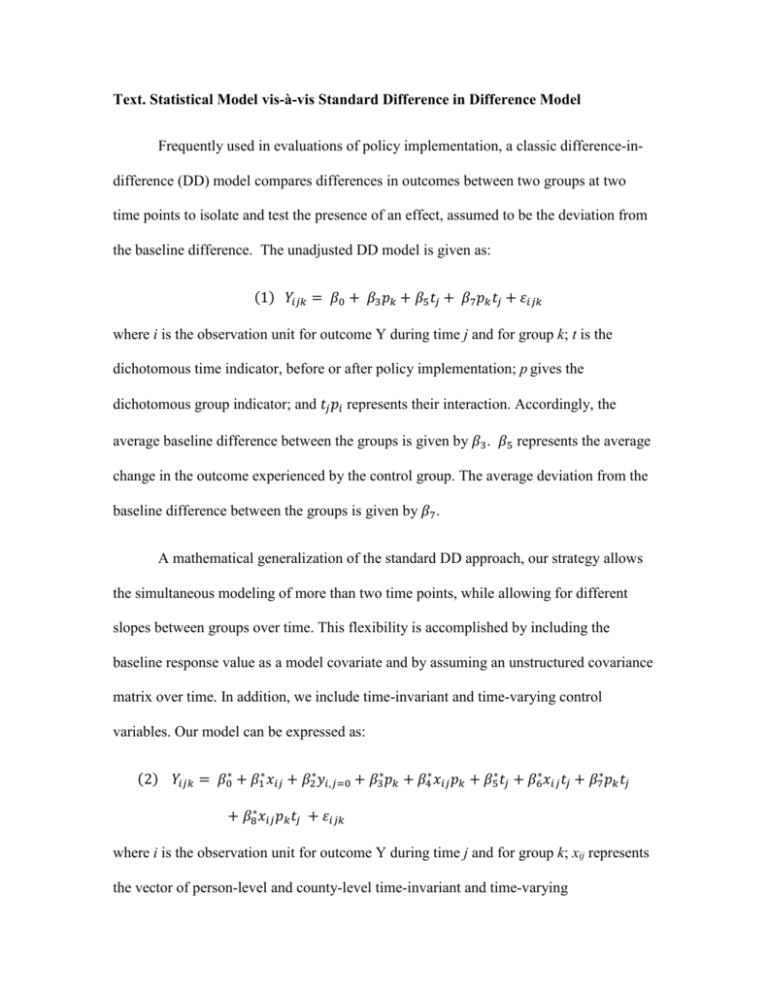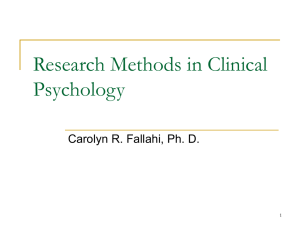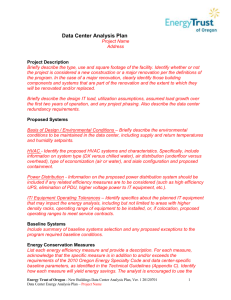Text. Statistical Model vis-à-vis Standard Difference in Difference
advertisement

Text. Statistical Model vis-à-vis Standard Difference in Difference Model Frequently used in evaluations of policy implementation, a classic difference-indifference (DD) model compares differences in outcomes between two groups at two time points to isolate and test the presence of an effect, assumed to be the deviation from the baseline difference. The unadjusted DD model is given as: (1) 𝑌𝑖𝑗𝑘 = 𝛽0 + 𝛽3 𝑝𝑘 + 𝛽5 𝑡𝑗 + 𝛽7 𝑝𝑘 𝑡𝑗 + 𝜀𝑖𝑗𝑘 where i is the observation unit for outcome Y during time j and for group k; t is the dichotomous time indicator, before or after policy implementation; p gives the dichotomous group indicator; and 𝑡𝑗 𝑝𝑖 represents their interaction. Accordingly, the average baseline difference between the groups is given by 𝛽3. 𝛽5 represents the average change in the outcome experienced by the control group. The average deviation from the baseline difference between the groups is given by 𝛽7. A mathematical generalization of the standard DD approach, our strategy allows the simultaneous modeling of more than two time points, while allowing for different slopes between groups over time. This flexibility is accomplished by including the baseline response value as a model covariate and by assuming an unstructured covariance matrix over time. In addition, we include time-invariant and time-varying control variables. Our model can be expressed as: (2) 𝑌𝑖𝑗𝑘 = 𝛽0∗ + 𝛽1∗ 𝑥𝑖𝑗 + 𝛽2∗ 𝑦𝑖,𝑗=0 + 𝛽3∗ 𝑝𝑘 + 𝛽4∗ 𝑥𝑖𝑗 𝑝𝑘 + 𝛽5∗ 𝑡𝑗 + 𝛽6∗ 𝑥𝑖𝑗 𝑡𝑗 + 𝛽7∗ 𝑝𝑘 𝑡𝑗 + 𝛽8∗ 𝑥𝑖𝑗 𝑝𝑘 𝑡𝑗 + 𝜀𝑖𝑗𝑘 where i is the observation unit for outcome Y during time j and for group k; xij represents the vector of person-level and county-level time-invariant and time-varying characteristics which we added as control variables; yi,j=0 is an individual’s compliance in the baseline year; p is the dichotomous group indicator; and t is a categorical variable representing time, which is allowed to have more than two levels. The DD model is a specific case of this more generalized model. Our approach borrows strength over time, thus increasing overall statistical power. Under the standard DD approach, this analysis would require four paired time comparisons; our analytic strategy allows us tocompare all four post-implementation time points simultaneously; subsequently, we are not bound by the parallel trend assumption. The model that we use further generalizes the DD model by allowing the baseline difference to be any value, which is restricted to 1.0 in DD (also by the parallel trend assumption). To illustrate, consider a two time-point study that has baseline compliance, yi,j=0, and a post-baseline compliance, yi,j=1, for subject i in group k. By way of the cell mean ANOVA model, the difference score yi,j=1 – yi,j=0 can be expressed as: (3) 𝑑𝑖,𝑘=k = 𝑦𝑖,𝑗=1,𝑘=k − 𝑦𝑖,𝑗=0,𝑘=k = 𝜇𝑘=k + 𝜀𝑖 . Rearranging terms: (4) 𝑦𝑖,𝑗=1,𝑘=k = 1 ∙ 𝑦𝑖,𝑗=0,𝑘=k + 𝜇𝑘=k + 𝜀𝑖 where 𝜇𝑘 , the average change score for fixed group k, is given by equation (1) as: (5) 𝜇𝑘=k = 𝛽5 + 𝛽7 𝑝k and substituting for 𝜇𝑘=k gives the following result: (6) 𝑦𝑖,𝑗=1,𝑘=k = 1 ∙ 𝑦𝑖,𝑗=0 + 𝛽5 + 𝛽7 𝑝k + 𝜀𝑖 . This equation can be generalized to allow for varying group k: (7) 𝑦𝑖,𝑗=1,𝑘 = 1 ∙ 𝑦𝑖,𝑗=0 + 𝛽3 𝑝𝑘 + 𝛽5 + 𝛽7 𝑝𝑘 + 𝜀𝑖𝑘 . Allowing for more than one post-baseline measure and non-zero intercept: 𝑦𝑖𝑗𝑘 = 𝛽0 + 1 ∙ 𝑦𝑖,𝑗=0 + 𝛽3 𝑝𝑘 + 𝛽5 𝑡𝑗 + 𝛽7 𝑝𝑘 𝑡𝑗 + 𝜀𝑖𝑗𝑘 This result reflects the special case in our model where 𝛽2∗ = 1, and individual control variables, other than the baseline measure compliance, are removed. Model Fitting Details The predictor variables (as described in the article text) were placed into the full model for each outcome in a fixed order: main effects, time, interactions within main effects, and interactions between main effects and time. For each of these full models, fixed-order backwards selection of predictor variables with alpha = 0.05 was used to arrive at the reduced models. Performing significance tests therefore required testing the higher-order interaction variables first. Thus, in the backwards selection process, only those main effect variables that did not have a statistically significant interaction were tested; any other main effects were retained. Finding general agreement in terms retained between the models, we established one final reduced model form for consistency.











